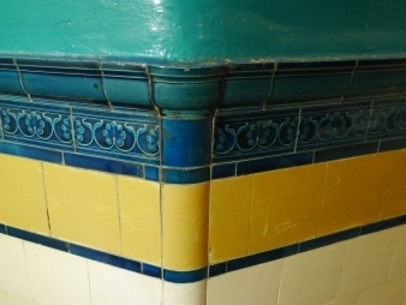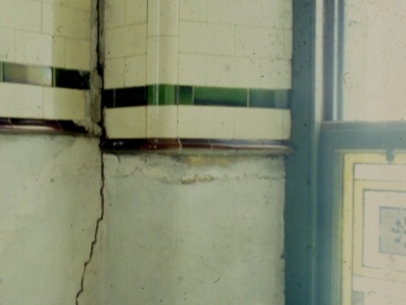Close (stair) walls
Thinner and built on lighter foundations than external walls, close (stair) walls may settle or the foundations may be washed away by leaking pipes, leading to subsidence and separation cracks.
The walls that support the stairs are normally single brick walls (called 'half brick'). With plaster, this results in a wall about 150mm thick. The plaster on both sides of these walls contributes to their strength, so 'boss' or hollow sounds when you tap walls indicates that plaster has come away from the wall and should be fixed.
Take any structural symptoms (particularly bulges) seriously.
Close painting
Internal paintwork can last for ten years, depending on the use and cleaning of the close.
A breathable emulsion paint is best used on the upper wall and ceiling plasterwork. If there are signs of flaking paint or blisters, then the surface may need to be scraped back and sealed before being repainted.
The dado
The dado is the bottom half of the close wall. It is normally made of a hard mortar and gloss-painted or tiled.

If you have the original Victorian close tiles, then it is best to try to conserve them. Tiling which is 'boss' (hollow when tapped) may be ready to fall off. This may be the result of moisture from the ground or use of the wrong cleaning agents. Where new tiles fall off the wall, this may be because the wrong render or wrong adhesive has been used.
Cracked and loose tiles can be taken out and replaced, although finding matching tiles can be tricky. If your building is listed, approach a ceramic conservator. Replacing the odd tile with a non-matching tile may be a better solution than replacing all the tiles. Gypsum plaster should not be used behind close wall tiles as it can hold moisture.
Wall tiles should be cleaned with soap and water, nothing more. If painted over, it may be necessary to use a water based paint stripper or simply remove the paint by using a sharp scalpel blade.
Close walls are plastered 'on the hard' (plastered directly onto the brick). This means that the plaster may crack at wall junctions with external stone walls that tend to have lath and plaster finish.
Dampness caused by lack of a damp proof course (DPC) in these walls can lead to tiles or plaster becoming detached at ground level.
Separation cracks may occur where the external wall settles more than the internal close walls, although sometimes it is simply caused by thermal movement between different wall finishes.

Professional help recommended?
Although the work may appear straightforward, ensure your builder or tradespeople have the skills for the job. If in any doubt, get professional help to specify and organise the repair.
Who pays?
These are normally common or mutual repairs. There may be particular issues with main door flats and shops.
Further information